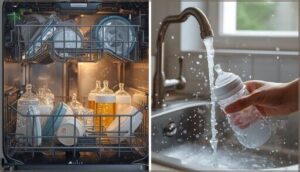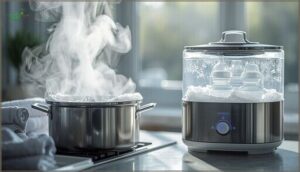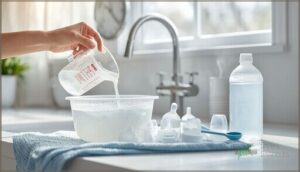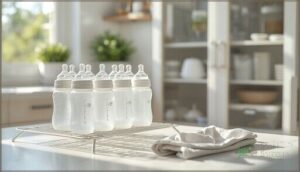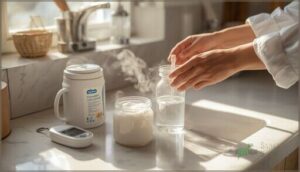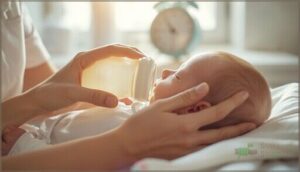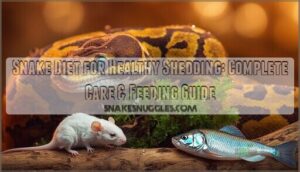This site is supported by our readers. We may earn a commission, at no cost to you, if you purchase through links.
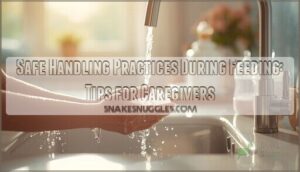
Every time you prepare a bottle or spoon-feed your baby, invisible risks lurk on your hands, countertops, and feeding equipment. Foodborne pathogens don’t announce themselves with warning signs, yet they cause thousands of infant illnesses each year.
The good news? Research shows that proper hand hygiene alone can reduce pathogen transfer by up to 80%, and thorough handwashing technique eliminates up to 99% of harmful germs.
Safe handling practices during feeding aren’t complicated, but they require consistency and attention to detail. From the moment you touch that bottle to the second it reaches your baby’s mouth, each step matters. Understanding when to wash your hands, how to prevent cross-contamination, and the right way to clean feeding equipment creates a protective barrier between your child and potential illness.
Table Of Contents
Key Takeaways
- Proper handwashing technique—scrubbing for at least 20 seconds with soap and warm water—reduces pathogen transfer by up to 80% and eliminates up to 99% of harmful germs when done at critical moments like before feeding and after diaper changes.
- Bottles and feeding equipment require complete disassembly and thorough cleaning after every use, with sanitization through boiling (10 minutes at 100°C), steam sterilization, or dishwasher cycles above 155°F to eliminate 99.9% of bacteria and prevent biofilm buildup.
- Prepared infant formula must be used within two hours at room temperature or discarded, and powdered formula should be mixed with water heated to at least 70°C to kill harmful bacteria like Cronobacter and Salmonella.
- Air-drying feeding equipment on a clean, dedicated rack prevents contamination better than towel-drying, and sterilized items should be stored in closed cabinets away from multi-use areas to maintain their safety between feedings.
Essential Hand Hygiene During Feeding
Hand hygiene stands as your first line of defense against harmful bacteria that can make babies sick. When you’re caring for an infant, knowing when and how to wash your hands properly isn’t just good practice—it can reduce foodborne pathogen transfer by up to 80%.
Proper hand hygiene can reduce the risk of passing harmful bacteria to babies by up to 80%
Let’s walk through the key moments and techniques that keep feeding time safe for your little one.
Proper Handwashing Techniques for Caregivers
When caring for your baby, proper handwashing technique makes all the difference. Research shows thorough handwashing reduces pathogens by up to 99%, protecting your little one from contamination. Low caregiver compliance contributes to the spread of illness.
Follow these steps to prevent germ contamination:
- Wet hands with warm water and apply soap
- Scrub all surfaces for at least 20 seconds, including between fingers
- Clean underneath nails using a nail brush
- Rinse thoroughly under running water
- Air-dry with clean towels or let air-dry completely
These safe infant feeding practices create a protective barrier against illness.
When and How Often to Wash Hands
Knowing how to wash your hands properly sets the stage—but timing matters just as much. The CDC identifies critical handwashing moments: before, during, and after preparing food, before feeding your child, and after diaper changes. Authority guidelines recommend at least 20 seconds with soap and warm water.
Healthcare workers wash hands up to 100 times per shift. While you won’t need that frequency at home, washing more than 10 times daily greatly reduces respiratory and gastrointestinal disease transmission. Disease prevention statistics show households where caregivers wash hands before food prep have an 81% lower risk of childhood diarrhea.
Focus on these critical handwashing moments:
| Timing | Why It Matters |
|---|---|
| Before feeding | Prevents germ contamination from hands to food |
| After diaper changes | Blocks fecal-oral disease transmission |
| After touching pets | Removes animal-borne pathogens |
Research reveals concerning barriers and gaps in compliance frequency data. Only 15% of mothers wash hands after using the bathroom, and 32% skip handwashing after diaper changes. These lapses directly increase infection risk for infants.
To maintain safe infant feeding practices and proper hygiene, wash your hands:
- Before preparing bottles or formula
- Before each feeding session
- After handling raw ingredients
- After cleaning up feeding areas
- After touching anything that contacts germs
Don’t let barriers like time pressure compromise your baby’s health. Keep soap and clean towels within reach of feeding areas to make frequent hand washing techniques easier to maintain throughout the day. Infants are particularly vulnerable because of underdeveloped immune systems.
Preventing Cross-contamination During Feeding
Clean hands alone won’t protect your baby if contaminated utensils or surfaces introduce germs during feeding. Cross-contamination happens when pathogens like Staphylococcus aureus transfer from your hands to spoons, then into formula—allowing bacteria to multiply between feedings.
Prevent contamination through utensil separation and surface disinfection:
- Use dedicated cutting boards for infant foods away from raw meat
- Store feeding equipment in sealed storage containers separate from allergens
- Wipe high-touch surfaces like countertops with disinfectant before preparing bottles
- Disassemble and wash bottle parts immediately after each feeding
Caregiver education on allergen awareness and proper cleaning reduces infection risks considerably.
Cleaning and Sanitizing Feeding Equipment
Keeping your baby’s feeding equipment clean isn’t just about appearances—it’s about preventing harmful germs from making your little one sick. You’ll need to follow specific steps each time you clean bottles, nipples, and other feeding items to make certain they’re truly safe.
Let’s walk through the most effective methods you can use to clean and sanitize this essential equipment.
Disassembling Bottles and Feeding Items
Before you begin cleaning, take every bottle completely apart—nipples, rings, valves, and caps. This disassembly frequency matters because biofilm can hide in seams, increasing contamination risk by up to 43.8%. Component inspection during each disassembly helps you spot cracks that harbor bacteria. Proper disassembly also minimizes microplastic exposure and residue risks from trapped milk or formula.
Here’s what to separate:
| Infant Feeding Items | Component Type | Why Disassemble |
|---|---|---|
| Bottles | Main container | Reaches base and threads |
| Nipples | Feeding surface | Removes milk residue completely |
| Rings | Securing piece | Cleans hidden grooves |
| Valves | Flow regulator | Prevents biofilm prevention failure |
Dishwasher Vs. Handwashing Methods
When you’re weighing dishwasher sanitization against handwashing hygiene, the dishwasher wins on both water consumption and energy efficiency. It uses just 3–4 gallons per cycle—far less than the 15 gallons you’d use handwashing with a running faucet.
Plus, dishwashers reach over 155°F, eliminating 99.999% of bacteria. Handwashing in a wash basin with a bottle brush can’t match that, and residue risks increase when sponges harbor germs.
Boiling and Steam Sterilization Processes
Beyond the dishwasher, boiling sterilization and steam sanitization offer powerful ways to protect your baby. Boiling feeding equipment at 100°C for 10 minutes kills bacteria effectively—just fully submerge disassembled bottles with no air pockets.
Steam sterilizers use vapor to achieve 99.9% bacterial reduction in less time without damaging silicone or plastic components, making them gentler for frequent cleaning.
Safe Bleach Sanitization Practices
When you need an alternative to boiling, bleach sanitization offers effective germ control for infant feeding items. Prepare a bleach solution using 1 tablespoon of unscented bleach per gallon of water—yielding about 200 ppm—to meet regulatory compliance standards.
Confirm a contact time of at least 2 minutes on fully cleaned items before air-drying. Be mindful of exposure risks: proper bleach concentration prevents respiratory irritation while preventing germ contamination effectively.
Safe Storage of Feeding Items
After you’ve cleaned your baby’s bottles and feeding equipment, proper storage becomes just as important as the washing itself. How you dry and where you keep these items can make the difference between safe feeding gear and a breeding ground for germs.
Let’s walk through the best practices for drying, storing, and maintaining your feeding supplies so they stay clean between uses.
Air-drying Vs. Towel-drying
After cleaning and sanitizing bottles, choosing the right drying method matters for your baby’s safety. Air-drying on a clean drying rack considerably reduces microbial transfer compared to towel-drying, which can introduce contamination.
Though airdry methods take longer—usually one to two hours—hygiene guidelines strongly favor this approach, especially for vulnerable infants under two months, premature babies, or those with weakened immune systems.
Storing Items in Clean, Protected Areas
Once your feeding items are dry, where you store them makes all the difference. Place bottles and parts in a closed kitchen cabinet designated only for clean dishes—this cabinet organization approach greatly reduces contamination risk. Avoid multi-use storage areas.
Moisture control and environmental monitoring help maintain hygiene. Limit access to only those preparing feeds, and follow strict storage protocols to keep sanitizing efforts effective.
Assembling and Storing Bottles Safely
After bottles dry completely, proper assembly sets the stage for safe storage. Place the valve into the nipple’s backside, then snap it into the collar. Tighten the collar until closed—not over-tightened—to prevent leakage.
Store assembled bottles upright in your clean cabinet within 24 hours of sterilization. This storage duration maintains sterility whether you’re preparing infant formula or expressed breast milk, reducing contamination risk effectively.
Maintaining Drying Rack Hygiene
Your drying rack needs attention too. Wash and sanitize it every few days using hot, soapy water or a dishwasher with heated drying. For infants under two months or those with weakened immunity, clean it daily.
Damp racks harbor mold and bacteria that transfer directly to bottles. After sanitizing, let the rack air-dry completely in a dust-free spot to prevent microbial growth risks.
Preparing and Handling Infant Food Safely
Once your feeding equipment is clean and safely stored, the next step is handling the food itself with care. Whether you’re mixing formula or working with expressed breast milk, proper preparation protects your baby from harmful germs.
Let’s walk through the key practices that keep every feeding safe from start to finish.
Safe Preparation of Infant Formula
When preparing infant formula, you’re setting the stage for your baby’s health and safety. Powdered formula isn’t sterile, so proper water temperature and sterilization matter more than you might think.
- Mix formula with water heated to at least 70°C to kill harmful bacteria like Cronobacter and Salmonella
- Wash your hands for 20 seconds with soap before touching baby bottles or preparation surfaces
- Use prepared formula within 2 hours at room temperature or refrigerate immediately
- Check expiration dates on formula containers and discard opened powdered formula after one month
Handling and Storing Expressed Breast Milk
Your breast milk deserves the same care as formula. Store expressed breast milk in clean, BPA-free glass or hard plastic containers with tight lids—not general household bags.
Freshly expressed milk stays safe at room temperature for up to 4 to 6 hours, but refrigeration at 39°F or colder extends storage to 4 days. Freezing at 0°F preserves quality for 6 to 12 months, supporting safe handling of expressed breast milk and reducing contamination risk factors.
Cleaning Formula Containers and Utensils
Formula containers demand the same rigorous cleaning as bottles. Disassemble each part, then scrub with a dedicated bottle brush and dish soap for at least 30 seconds—brush effectiveness combined with detergent residue removal cuts contamination dramatically. Rinse thoroughly under running water.
Choose dishwasher sanitizing with hot water or boiling for five minutes. Air-dry completely on a clean rack before storing in a protected cabinet.
Preventing Germ Contamination During Feeding
During infant feeding, germs lurk in unexpected places—contaminated water, airborne particles, and unwashed hands. You can’t see them, but their impact is real.
Clean and sanitize bottles before every use, and always wash your hands beforehand. Use safe water for mixing infant formula. Choose appropriate sanitizer types when dishwashers aren’t available.
Frequent cleaning protects your baby from harmful germ sources that threaten their health.
Recognizing and Responding to Feeding Risks
Even with the best hygiene practices, things can still go wrong during feeding. Knowing what to watch for and when to act can protect your baby from illness or injury.
Here’s what you need to recognize and how to respond when feeding risks arise.
Signs of Contamination or Unsafe Feeding
Spotting problems early protects your baby from germs and illness. Formula discoloration—shifting from white to brown or yellow—signals spoilage. Unusual odors, clumps or lumps in powder, and bloated containers all indicate contamination. Altered taste, especially sourness, means the formula isn’t safe.
During infant feeding, watch for vomiting, diarrhea, or fever in your baby. These signs demand immediate attention for patient safety and medical error prevention.
When to Seek Help From Healthcare Professionals
When should you call your baby’s doctor? Dehydration symptoms like fewer than four wet diapers daily, sunken soft spots, or tearless crying need immediate attention. Respiratory distress—breathing faster than 60 breaths per minute, grunting, or blue lips—requires emergency care. Behavior changes, including lethargy or inability to wake, signal urgent problems.
Fever concerns in babies under three months (≥100.4°F) demand prompt evaluation. Weight issues, like not regaining birth weight by two weeks, warrant professional guidance for infant feeding, breastfeeding, or infant formula adjustments supporting pediatric nutrition and healthcare quality.
Tips for Safe Feeding in Hospital and at Home
Whether you’re in the hospital or your own kitchen, clean hands form your first line of defense. Hospital protocols emphasize strict hygiene during infant feeding, but home environment safety matters just as much.
Wash hands before every feeding session, sanitize bottles properly, and use correct feeding techniques. Caregiver training reduces risks considerably—proper handwashing alone prevents up to 80% of infections, protecting infant nutrition and supporting breastfeeding success through patient safety practices.
Frequently Asked Questions (FAQs)
Can I reuse leftover formula from previous feeding?
Once your baby’s lips touch the nipple, don’t save leftover formula.
The CDC and FDA recommend discarding it within one hour to prevent bacterial growth risks that compromise infant nutrition and safety.
How long can prepared formula sit out unrefrigerated?
Prepared infant formula shouldn’t sit out unrefrigerated longer than two hours. Bacterial growth accelerates rapidly at room temperature, creating serious health risks.
Official guidelines from the CDC and FDA recommend immediate refrigeration or disposal after this window.
Are silicone nipples safer than latex or rubber?
Silicone nipples offer advantages over latex: they’re hypoallergenic, resist chemical leaching, and withstand frequent sanitizing without degrading.
However, some infants prefer latex’s softer texture, which better mimics skin for latching comfort.
Should I sterilize pacifiers the same as bottles?
You don’t need to sterilize pacifiers as often as bottles. Daily sterilization matters most during early immune development, especially under three months.
Bottles require more frequent sanitizing due to milk residue that promotes bacterial growth.
Can I microwave bottles to warm milk quickly?
Microwaves create dangerous hotspots in bottles despite appearing cool outside—risking burns and destroying breast milk’s protective nutrients. Official recommendations strongly advise against microwaving.
Instead, use warm water baths or bottle warmers for safe, even heating.
Conclusion
The feeding practices you establish today shape your baby’s health for years to come. Each handwashing, each sterilized bottle, each moment of vigilance builds immunity against invisible threats.
Safe handling practices during feeding aren’t just rules—they’re your daily defense against pathogens that prey on vulnerable immune systems. When you maintain these standards consistently, you’re not being overprotective. You’re being prepared. And in infant care, preparation isn’t paranoia—it’s the difference between illness and wellness.
- https://www.foodprotection.org/members/fpt-archive-articles/2023-09-identifying-predictors-of-safe-food-handling-practices-among-canadian-households-withchildre/
- https://www.meritech.com/blog/ensuring-hand-hygiene-compliance-for-food-safety
- https://pubmed.ncbi.nlm.nih.gov/19556578/
- https://www.centerforproducesafety.org/research-database/cross-contamination-risks-in-dry-environments
- https://www.who.int/news-room/fact-sheets/detail/infant-and-young-child-feeding


